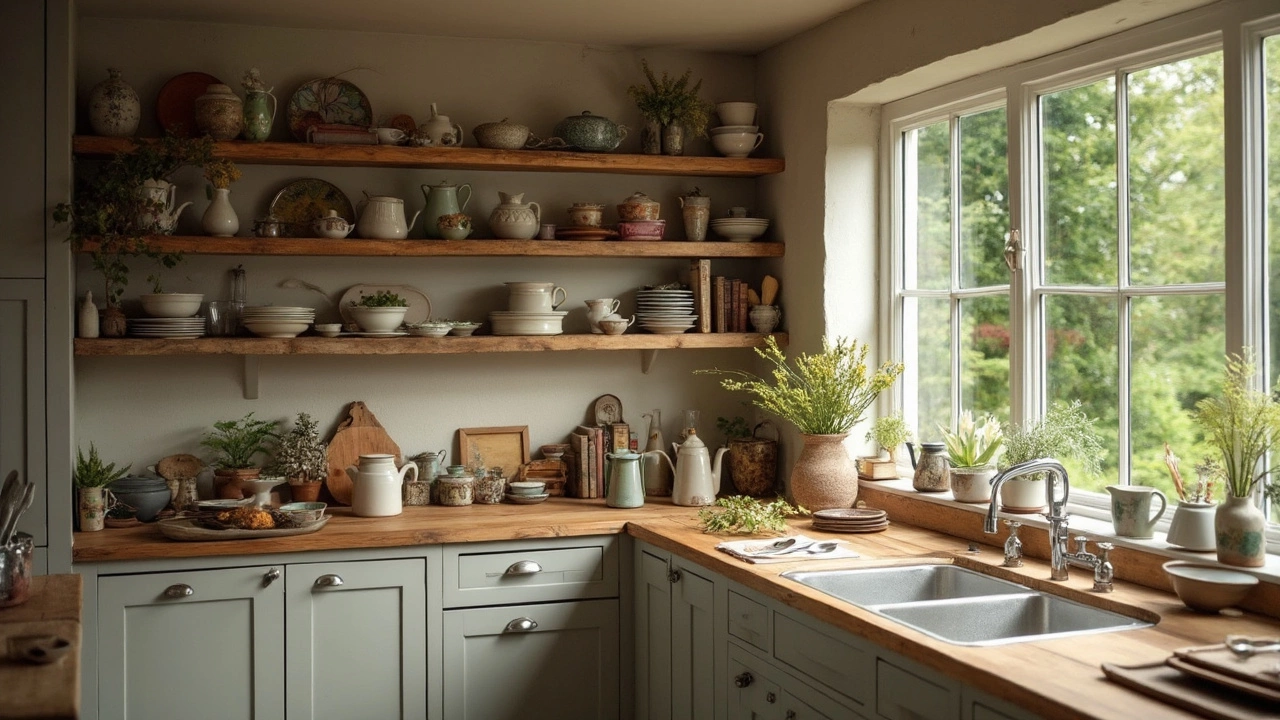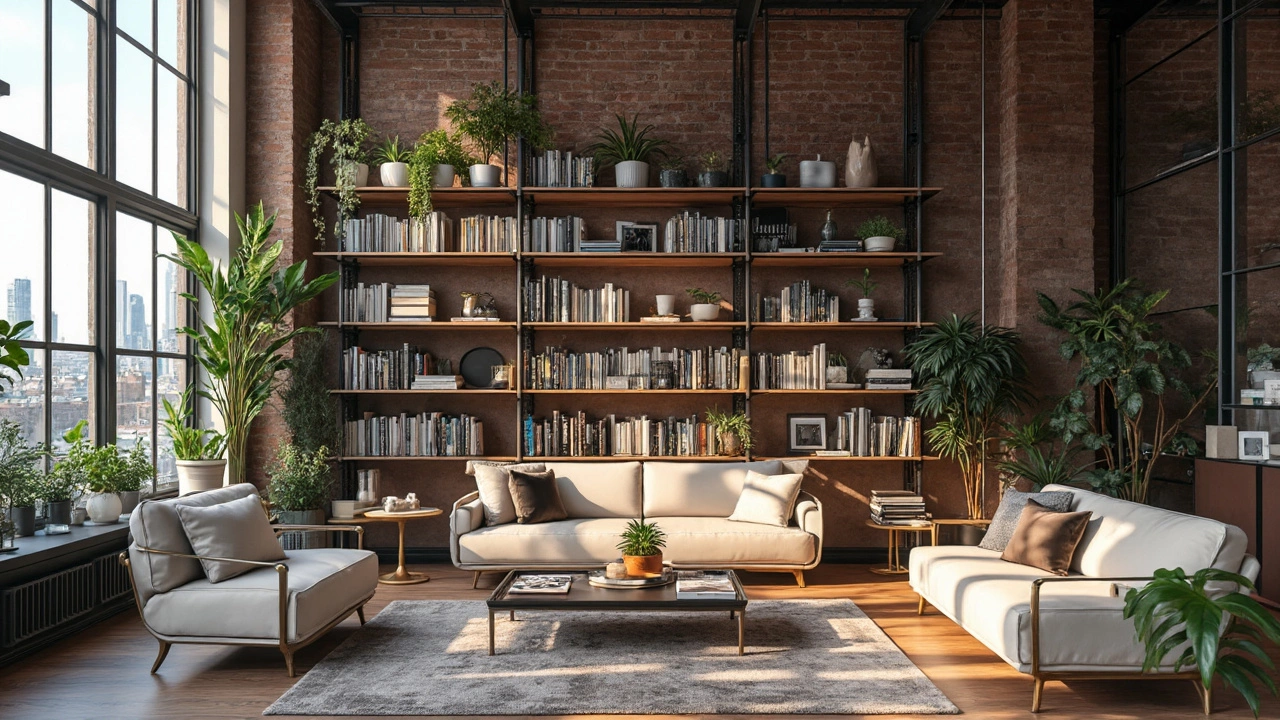Does Open Shelving Really Save Money?
 Mar, 20 2025
Mar, 20 2025
You've probably seen those Pinterest-perfect kitchens with open shelves displaying color-coordinated dishes, and maybe you're thinking, "Can this save me money?" Well, you're in luck. Open shelving not only spices up your space with a modern touch but also saves some bucks. How so? Let's break it down.
First off, open shelving can cost less than traditional cabinets because you're using less material. No doors, no fancy hinges—just shelves and supports. This simplicity often translates into savings. But here's the deal: you need to get your act together when it comes to organization. With everything on display, tidiness isn't just a suggestion; it's a must.
Think about material choices too. Sure, you can splash on expensive woods, but you don't have to. There are budget-friendly alternatives like plywood or even reclaimed wood that give you a great look for less. These choices help you stick to budget without sacrificing style.
- Why Open Shelving is Popular
- Cost Comparison to Traditional Shelving
- Maximizing Savings with Smart Choices
- Potential Downsides to Consider
Why Open Shelving is Popular
So, what's the deal with open shelving these days? It's more than just a craze. Open shelving is gaining traction because it's functional, stylish, and, importantly, it can be a cost-saving game-changer. Let's delve into why so many folks are knocking the doors off their cabinets.
Trend Meets Function
Open shelving isn't just about showing off your pretty plates. It’s practical, too. By providing easy access to items you use daily, like cups or cereal bowls, you're shaving time off your morning routine. Plus, you can spot when you're running low on essentials at a glance.
Sarah Richardson, a renowned interior designer, once said,
"Open shelving can transform a space by adding personality and practicality at the same time. It's about creating an open-hearted kitchen vibe."No wonder it’s so appealing for modern homes trying to achieve that homey feel!
Aesthetic Appeal
An open shelf can turn basic dishes into decor. The whole idea is about blending form and function in an appealing way. You showcase your style without feeling like you're trying too hard. The aesthetic is minimalist yet inviting, making it popular among those who love both clean lines and a personalized touch.
Budget-Friendly Options
Here's a nifty reason for the rise of open shelving: It's easier on the wallet. Unlike typical cabinets, which can be costly due to intricate designs and multiple materials, open shelves are straightforward. They use less wood or other materials, which typically means less money spent.
Versatility in Design
Options are endless when it comes to style. From rustic wooden planks to industrial metal brackets, open shelves can fit any room's theme. Want to change your color scheme? Just swap out or rearrange items to refresh the look—no need to repaint or replace entire units.
With these benefits, it's no wonder open shelving is a hot choice. It's a practical, stylish, and budget-friendly option that can fit in almost anywhere. Whether you're redoing your kitchen or just looking to declutter your life a bit, open shelves might just be the answer.
Cost Comparison to Traditional Shelving
Alright, let's get into the nitty-gritty of how open shelving stacks up against old-school cabinets. When you look at the raw materials, open shelves typically require less lumber than traditional cabinets. You can skip the doors, hinges, and sometimes even the back panels, which all add up to savings. Even a basic set of cabinets can make your wallet wince, whereas open shelves often go light on the budget.
So how much are we talking? A standard set of kitchen cabinets can run you anywhere from $4,000 to $13,000, depending on the size and materials. On the flip side, open shelving installations usually slip in around the $1,500 to $5,000 range. That's a pretty decent difference, right?
Material Choices Matter
However, the cost isn't just about the initial setup. What kind of materials should you use? Fancy woods will drive up your costs, but there are plenty of budget-friendly and stylish alternatives. Think about using MDF, plywood, or even reclaimed wood if you want something eco-friendly and cool. Get creative with brackets—simple metal ones can look sleek and cost less than ornate options.
Installation and Labor
Let's not forget the labor costs. Installing traditional cabinets can be a time-consuming affair. The more complex the cabinetry, the higher the labor fees. Open shelving? It’s often a quicker job, sometimes even a DIY dream if you’re handy with tools.
| Feature | Traditional Shelving | Open Shelving |
|---|---|---|
| Material Cost | $200 - $1,000 per linear foot | $100 - $300 per linear foot |
| Installation Cost | $70 - $200 per hour | $50 - $150 per hour |
| Time for Setup | 1-2 days | 4-8 hours |
All in all, if you’re looking to save some cash and don’t mind showing off your dish collection in the process, open shelving might just be the way to go. Keep the look clean, and your budget happy.

Maximizing Savings with Smart Choices
So, you're ready to save some cash with open shelving, but where do you start? Making a few smart choices can go a long way in keeping costs down while giving your home that chic, organized look.
Choosing the Right Materials
First things first, material is everything. If you're looking to save, consider options like pine or plywood—both are affordable and can be easily stained or painted to match your decor. Plus, these materials are typically lighter, making installation a breeze.
DIY vs. Professional Installation
Speaking of installation, going the DIY route can save you quite a bit compared to hiring a pro. Many open shelving systems come with easy-to-follow instructions. Don't be afraid to roll up your sleeves and get your hands dirty. If you want it done just so, though, getting a carpenter could be worth the investment.
Smart Layout Considerations
When planning your shelves, keep practicality in mind. Shelves arranged too high or too low might look interesting, but they can become impractical storage-wise, leading to wasted space and materials. Your daily-use items should be within easy reach to make the most of your space.
Reusing and Recycling
Want to pinch pennies and be eco-friendly at the same time? Consider using reclaimed wood or even refurbishing materials you already have. A little sanding and a fresh coat of paint can do wonders, transforming old pieces into something special.
Accessorize Wisely
Finally, smart accessories can make all the difference in keeping your shelves functional. Think about using baskets or bins to keep things organized and uncluttered. Clear jars are perfect for kitchen staples and they’re a stylish way to bring in some uniformity.
By focusing on these practical tips, you can implement open shelving that keeps your wallet happy while creating a stunning visual impact in your home.
Potential Downsides to Consider
While open shelving can be a fantastic way to save money and add some style, it's not all sunshine and rainbows. There are a few things to keep in mind before you start replacing all your cabinets with shelves.
Dust and Maintenance
One of the first things you'll notice is dust. Yup, without those cupboard doors, dust bunnies will happily take up residence on your dishes and whatever else you display. You'll find yourself cleaning your shelves and items more frequently. So, if you're someone who doesn't enjoy spending Saturday mornings dusting, it might be something to consider.
Clutter Ease
Open shelves can quickly turn into a chaotic mess if not managed well. Unlike closed cabinets where you can toss things in and slam the door, everything on open shelves is out for everyone to see. This means you have to be pretty disciplined about putting things back in their place and avoiding clutter. If you're not ready to sort your cereal boxes by height, open shelving might not be your friend.
Safety Concerns
Another consideration is safety. Especially if you have kids or pets, open shelves can be a little risky. Items can fall, and curious hands (or paws) can reach for things they shouldn't. Be extra cautious with what you place on lower, easily reachable shelves.
Limited Storage
Let's talk storage. Open shelving sometimes means less overall storage space compared to traditional cabinetry. You might find yourself with fewer drawers and compartments, needing to get creative with your organization skills.
Conclusion
Before jumping in and ripping off those cabinet doors, think about these potential downsides. Open shelving can be great, but it's important to weigh the pros and cons before making a decision. Sometimes being budget-friendly requires a bit more care and thought than meets the eye.